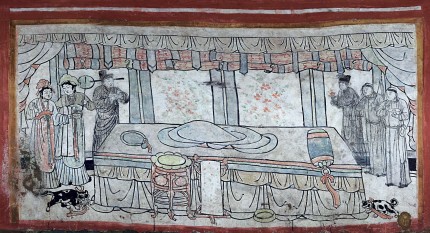
In 2011, archaeologists from the Datong Municipal Institute of Archaeology discovered a mural tomb near the railway station in Datong City, northern Shanxi province, China. The tomb dates to the Liao Dynasty, an empire that ruled over Mongolia, parts of what is today Russia, northern Korea and northern China from 907 to 1125 A.D., and although no human remains were discovered inside, the high quality and subject matter of the painting indicates the tomb owner was a wealthy man of Han Chinese ethnicity. The paintings are in excellent condition with only some losses from damage to the structure, and they present a vivid picture of daily life for the elite of the period.
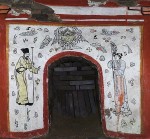 The murals begin at the entry to the tomb. The perimeter of the arched doorway and wall is painted in a thick stripe of red that doesn’t appear to have faded at all. Against a white background, two human figures are painted on either side of the entryway. The left guardian is a man wearing a black hat holding a staff. The right guardian is a woman holding aloft a feathered fan. Between them centered above the arch is the supernatural bird being Garuda, hovering amongst the clouds, watching over the entryway.
The murals begin at the entry to the tomb. The perimeter of the arched doorway and wall is painted in a thick stripe of red that doesn’t appear to have faded at all. Against a white background, two human figures are painted on either side of the entryway. The left guardian is a man wearing a black hat holding a staff. The right guardian is a woman holding aloft a feathered fan. Between them centered above the arch is the supernatural bird being Garuda, hovering amongst the clouds, watching over the entryway.
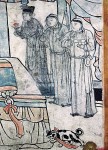
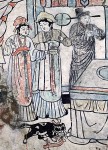 Inside the tomb, the largest mural is on the north wall. It’s a domestic scene depicting the tomb owner’s household. In the background are floor-to-ceiling windows with some excellent roll-up shades, a valance on top and curtains pulled back on the sides. There’s an empty bed in the center, flanked by attendants carrying different vessels and accessories. The stars of the show, however, are a black and white cat in front of the attendants on the left and a black and white dog in front of the attendants on the right. They both have ribbons tied around their necks and the cat is playing with a ball on the end of strip of silk.
Inside the tomb, the largest mural is on the north wall. It’s a domestic scene depicting the tomb owner’s household. In the background are floor-to-ceiling windows with some excellent roll-up shades, a valance on top and curtains pulled back on the sides. There’s an empty bed in the center, flanked by attendants carrying different vessels and accessories. The stars of the show, however, are a black and white cat in front of the attendants on the left and a black and white dog in front of the attendants on the right. They both have ribbons tied around their necks and the cat is playing with a ball on the end of strip of silk.
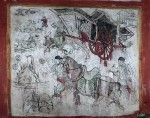 On the west wall is a dense, dynamic scene of travel through the countryside. An elaborate carriage on the top right of the wall is pulled by Bactrian camel. In the foreground a saddled horse trots, led by a groom. On the top left farmers carry water, plough and hoe their crops. A small figure of horse and rider in the bottom left looks to be transporting goods in packed saddlebags.
On the west wall is a dense, dynamic scene of travel through the countryside. An elaborate carriage on the top right of the wall is pulled by Bactrian camel. In the foreground a saddled horse trots, led by a groom. On the top left farmers carry water, plough and hoe their crops. A small figure of horse and rider in the bottom left looks to be transporting goods in packed saddlebags.
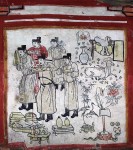 The east wall is a riot of food, drink and animals. Attendants on the left carry trays of food and beverages while on the ground in front of them are pitchers and bamboo steamers doubtless groaning with more of the same. On the top right is a saddle hanging on a rack with a lotus flower fountain to its left. A dear sits in front of the saddle. Other animals in the tableau are a crane, a turtle, and a snake crawling behind an axe on a platform. Between the deer and the crane are bamboo plants. A poem written on a banner to the right of the saddle ties the scene together: “Time tells that bamboo can endure cold weather. Live as long as the spirits of the crane and turtle.”
The east wall is a riot of food, drink and animals. Attendants on the left carry trays of food and beverages while on the ground in front of them are pitchers and bamboo steamers doubtless groaning with more of the same. On the top right is a saddle hanging on a rack with a lotus flower fountain to its left. A dear sits in front of the saddle. Other animals in the tableau are a crane, a turtle, and a snake crawling behind an axe on a platform. Between the deer and the crane are bamboo plants. A poem written on a banner to the right of the saddle ties the scene together: “Time tells that bamboo can endure cold weather. Live as long as the spirits of the crane and turtle.”
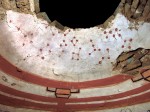 The ceiling of the tomb is the most damaged — more than half of painting is lost — but vermilion stars connected with lines into constellations are still clearly visible on what remains of it.
The ceiling of the tomb is the most damaged — more than half of painting is lost — but vermilion stars connected with lines into constellations are still clearly visible on what remains of it.
 The tomb was looted at some point in the last 1,000 years, but there was one artifact still present: a statue three feet high of a man sitting cross-legged wearing a black robe. Archaeologists believe it’s a representation of the tomb’s occupant. It may even have been a symbolic substitute for his body, a common practice for Buddhist burials at that time.
The tomb was looted at some point in the last 1,000 years, but there was one artifact still present: a statue three feet high of a man sitting cross-legged wearing a black robe. Archaeologists believe it’s a representation of the tomb’s occupant. It may even have been a symbolic substitute for his body, a common practice for Buddhist burials at that time.